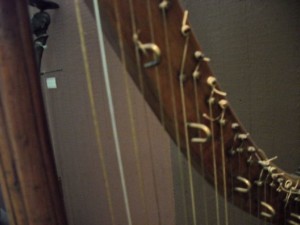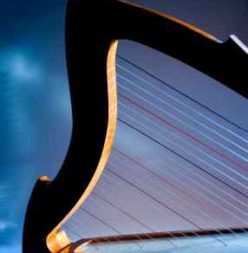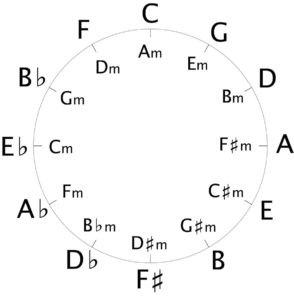
First things first. If you are brand new to the harp, before you worry about Celtic harp tunings, you’ll want to learn about the physical process of tuning the strings. It’s no fun to play an instrument that sounds awful! If you’ve never tuned a harp before, here are some wonderful Tuning Instructions from Thormahlen Harps (link opens in a new window).
There are several possible Celtic harp tunings, depending on whether or not your harp has sharping levers for every string (“full levers”). In any case, if you’re a beginner, you probably have your harp tuned in C major, which means that when all the levers are down, you have a simple C scale running from red string to red string–just like the white keys on the piano. If you don’t have any levers, then this is certainly your best choice.
If you have no levers, you can still go a long way with your harp. There is a lot of music for harp in the key of C, and you can easily transpose into that key if you find something in G or D that you want to play (these are the other most common keys for Celtic music, especially because fiddle players like these keys).
Some Celtic harps have “partial levers”, meaning that there are levers on some strings and not on others. If you have levers on just the F and C strings, you can tune in C major and play in G (by putting up the F levers to create F-sharps) and D (with F-sharps and C-sharps). This will take you a long way.
Now, suppose your harp also has levers on the B strings. It would be a waste to tune those strings to B, because raising the levers to create B-sharps will do you no good unless you have all the sharps to play in the key of C-sharp major (see the Circle of Fifths, below). C-sharp major is a rare key, even in advanced piano repertoire, so why would you need it?
Instead, the logical thing to do is tune those B strings as B-flats, which means you can play in the key of F, a much more useful key on the harp.
Full Levers and the Circle of Fifths
If you have full levers (levers on every string), you can get the most out of your harp by tuning in E-flat. If you look at the Circle of Fifths, you’ll notice that the key of E-flat has B-flat, E-flat and A-flat in it. If you raise one lever at a time, you can move from the key of E-flat, to B-flat, to F, to C, each time removing a flat to create the new key.
From here, you will start to create sharp keys by raising the remaining levers. The first sharp brings you to G, the next to D, the next to A, and the last lever to the key of E. You can see that these choices encompass 8 out of 12 possibilities of keys on the circle, From Eb to E.
Since your fully-levered harp has 7 levers (per octave), you can play in 7 keys, plus the key of C, giving you 8 keys total. If you tune your harp in the key of C, and thus start your 8 keys at C, reading clockwise, you’d end up with none of the useful flat keys, and several extra sharp keys you’d never use.
(Image Credit: By Joseph Harrington – Own work, Public Domain, https://commons.wikimedia.org/w/index.php?curid=1594809)
Not only are the 8 keys from E-flat to E the most helpful for all music published for lever harp (unless you’re in the UK, where the key of A-flat, with 4 flats, is also common)*, with this tuning you’ll have the most common accidentals available at the flip of a lever. For example, G-sharp is a common accidental in the key of A minor (related to C major, with no sharps or flats), so even if you rarely play in A major, you might find a lot of use for that G-sharp.
These Celtic harp tunings are for those with a certain amount of experience under their belts. If you’re just beginning to play the harp, by all means tune it in C for now. The world of multiple keys and colorful chords will certainly wait until you know your way around your harp.
*If you live in the UK, you might consider tuning your D strings to D-flat, because the key of Ab is more commonly used by harpers there. If you choose to do this, your circle will run from A-flat major to A major. The principle is still the same.


